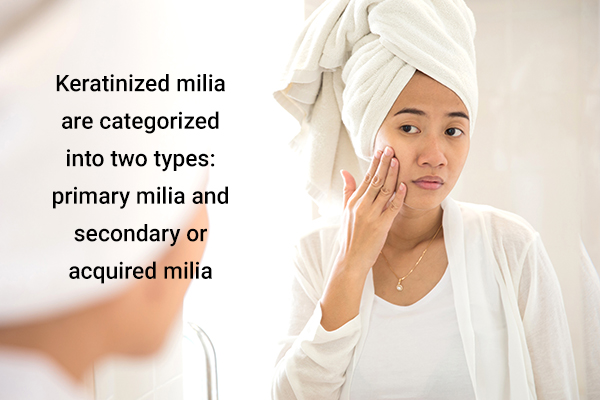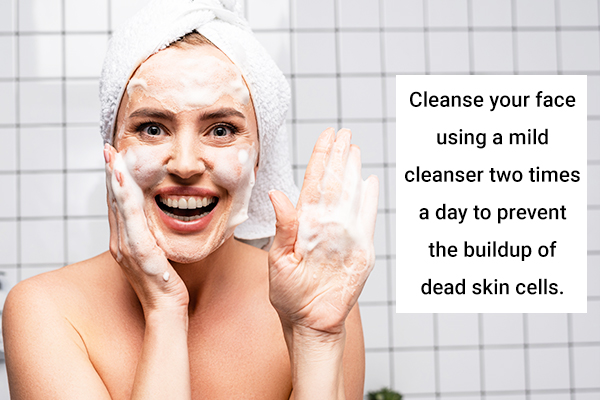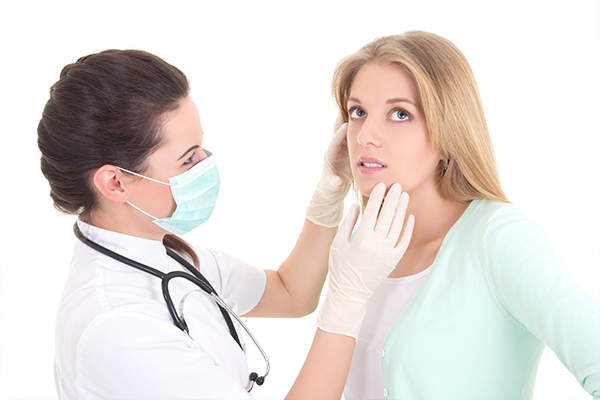In this article:
Milia, or milium cysts, are characterized by the appearance of small, milky-white papules on the face. These lesions are noncancerous and are formed from excessive keratin protein. The papules may also be found on the limbs, upper trunk, and genital area.

In some cases, the lesions may resolve, but in other cases, they may remain indefinitely. However, milium cysts are rarely a medical concern and are generally a cosmetic problem.
This article will discuss the causes and symptoms of milia and their treatment, home remedies, and prevention.
How Common Are Milia?
Milia can affect a person of any age, gender, and ethnicity. Congenital milia, which occur at birth and affect 40%–50% of newborns, are more common than milia developing later in life. (1)
Causes and Classification of Milia

Keratinized milia are categorized into the following two types: (2)
- Primary milia: They refer to congenital milia that are present from birth and occur from vellus hair follicles. Primary milia may also occur due to genetic disorders such as trichodysplasia and genodermatoses.
- Secondary or acquired milia: Milia occurring due to an inflammatory skin disorder, use of steroids or NSAIDs, atrophy, or skin trauma are known as secondary or acquired milia. This type of milia arises from the oil ducts, sweat ducts, or superficial skin.
Signs and Symptoms Associated With Milia Development
Milia are generally asymptomatic aside from the appearance of cysts or papules on the skin. These papules are small, milky-white to yellowish, smooth, raised bumps that may be singular, grouped, or distributed all over the skin.
The papules are most commonly seen over the scalp, eyelids, nose, gum border, cheeks, and roof of the oral cavity. In a few cases, milia cysts may be itchy but never painful.
Treatment for Milia
In most cases, primary milia lesions resolve within a few months without any treatment. If the lesions don’t resolve or you have secondary milia, the following treatments may be prescribed:
- Topical retinoids may be prescribed for widespread lesions.
- Evacuation may be done using a sterile needle or blade. This involves cutting the top of the lesion or squeezing out the contents.
- Laser treatment may be used to manage the lesions.
- Cryotherapy or diathermy and curettage may be employed to destroy the papules.
- Antibiotics such as minocycline may be given for milia en plaque.
Diagnosing Milia
Your doctor may conduct a simple physical exam to check if the lesions are milium cysts or not. In some cases, the doctor may drain the cyst and subject the contents to pathological testing to confirm the diagnosis and identify the cause.
Home Remedies to Control Milia
Several at-home measures can be taken to manage milia lesions. However, keep in mind that what works for some people may not work for you and vice versa.
You can try the following self-care measures for milia management:
1. Use a keratolytic agent

Keratolytic agents are helpful in removing the excess keratin associated with milia. You can use exfoliants such as alpha or beta hydroxy acids, including glycolic, salicylic, kojic, citric, or lactic acid.
Exfoliating your skin using these ingredients cleanses your skin, prevents the accumulation of dead skin cells, and reduces keratinized cysts. Make sure to use them in moderation.
2. Try DIY scrubs
You can use a tomato peel and sugar scrub, an orange peel scrub, or a rose water, (3) honey, and ground walnut or ground lentil scrub to help keep your skin free of dead skin cells.
Using these natural agents also helps manage inflammation. (4) Similarly, you may use cleansing agents containing manuka honey, orange peel extract, pomegranate peel extract, or lemon extract.
3. Use retinols
You may apply over-the-counter retinols, especially for night treatment.
4. Refrain from touching the cysts

Avoid touching the papules often. Also, do not try to extract or remove milia at home as this can increase the risk of scarring, bleeding, and infections.
5. Do not use occlusive
You should not use oily eye makeup removers or heavy moisturizers, especially if you are experiencing milia around the eyes. You may use a lighter eye cream and wear light makeup if needed.
6. Protect your skin from the sun
Use a sunscreen with SPF 30 or higher to prevent further damage from the harmful UV radiations.
Home Remedies to Avoid
On the Internet, you can find many home remedies that are said to help treat milia but are not supported by evidence. Using such remedies may worsen your milia.
When treating milia, avoid these ingredients:
- Vinegar
- Toothpaste
- Coconut, castor, or other plant oils
- Essential oils
- Aloe vera gel
- Lemon juice
Prevention of Milia
Primary milia, being congenital, cannot be prevented. In fact, it is also difficult to prevent secondary or acquired milia, since it develops spontaneously. However, you can address the risk factors associated with secondary milia. Take the following measures to reduce the risk of milia development:
1. Maintain facial hygiene

Cleanse your face using a mild cleanser two times a day to prevent the buildup of dead skin cells. Make sure to pat your face buildup instead of rubbing it with a rough cloth.
2. Exfoliate weekly
Exfoliating your skin helps remove dead skin cells and dirt, especially from your pores. It is best to exfoliate your skin at least once a week or even twice if you have normal to oily skin.
3. Apply sunscreen
Use a sunscreen with SPF 30 or higher, especially those containing zinc or titanium oxide, to prevent photodamage. Sunscreen should be applied before stepping out in the daytime even if it is cloudy outside.
4. Use products wisely
Add products such as antiaging creams and serums to your skin care routine. Avoid applying excessive or heavy makeup. Use only light creams and ointments, especially if you have oily skin.
5. Use age-appropriate products
This is obvious, but refrain from using adult products on babies as it increases the risk of infant milia.
Risk Factors for Milia
The following factors increase the risk of developing milia: (5)
- Hereditary or genetic factors
- Aging signs
- Sun damage
- Skin burns or rash
- Improper skin hygiene
- Excessive use of oil-based skin products that cause clogging of pores
- Skin conditions such as rosacea or dandruff
- Certain medications such as hydroquinone, phenols, corticosteroid, or 5-fluorouracil cream when used for long periods
- Lack of sleep
When to See a Doctor

Milia are not a serious medical concern but may cause cosmetic discomfort. If the cysts are bothersome for you, you may consult your doctor for the appropriate treatment.
You may also need to consult your doctor for multiple eruptive milia that develop suddenly as they may be a symptom of an underlying genetic condition such as basal cell nevus syndrome or Rombo syndrome.
Milia caused by epidermolysis bullosa also need to be checked by a doctor to avoid complications.
Final Word
Milia are noncancerous tumors made up of keratin that appear as white bumps on the skin. You may either have them from birth or develop them spontaneously at any age. Regardless, they do not cause any complications and do not require treatment in most cases.
If the cysts do not resolve, you may need to consult a doctor to check for underlying conditions. Several self-care measures can be taken to aid in the treatment of milia and to prevent the condition from recurring.
- Was this article helpful?
- YES, THANKS!NOT REALLY


